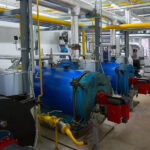Central Utility Plant Electrification Study
C&S led a study on the feasibility of eliminating natural gas usage at SAN’s central utility plant (CUP). SAN has set ambitious decarbonization goals with the ultimate objective of carbon neutrality, and natural gas usage at the CUP represents the single biggest technical hurdle to achieving these goals. SAN sought to understand what choices were available for complete natural gas replacement, their life cycle costs, and what other projects were needed to support that conversion.
The C&S team first conducted a comprehensive review of the current state of the electrical infrastructure
and energy consumption at SAN. Next, using datasets provided by SAN from the CUP building automation system (BAS), the C&S Team calculated and modeled the future heating and cooling demand at the CUP. The model considered a 30-year time horizon and compared the current natural gas baseline with electric boilers and air source heat pumps (ASHPs). The output from these models showed that ASHPs, phased in 10-unit modules over several years, would be the most efficient option with the same approximate life cycle cost as electric boilers. However, electric boilers would increase electricity demand substantially and a new substation would be required, making this option cost prohibitive.
The C&S team also evaluated siting considerations for ASHPs in the space-constrained CUP. C&S determined that while there was insufficient space in the CUP itself, and the roof lacked necessary
structural support for rooftop construction, three potential nearby sites would serve the purpose well. As part of the project, C&S facilitated workshops with SAN’s Utilities Working Group to review the preliminary results, consider siting options, and discuss the way forward. With ASHPs the clear winner, C&S developed a final report with the ASHPs as the recommended option. The report also identifies three supporting projects that would be needed for ASHPs to work: repairs to the hot water piping system to allow for low-temperature water, retro commissioning of the air handling units to run on low-temperature water, and an ASHRAE level II audit at Terminal 2 to focus on shrinking the heating and cooling footprint.

